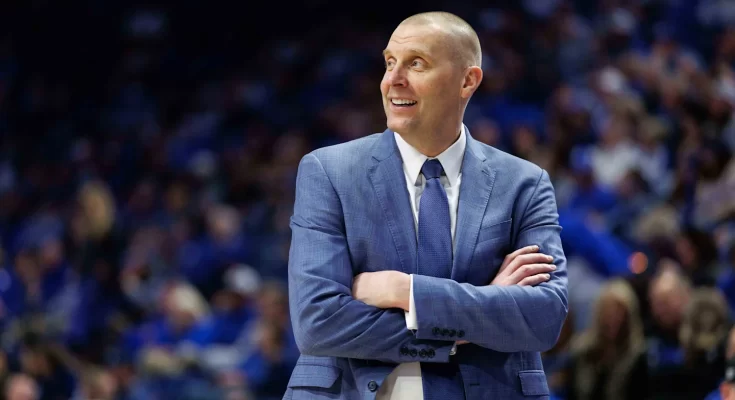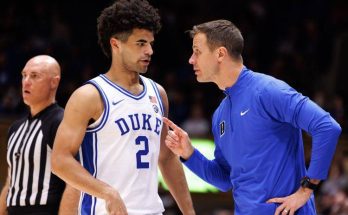Kentucky Wildcats Said to Be Allocating Nearly Half of Their Entire Revenue Share Budget Toward Building and Sustaining Their Basketball Program.
Kentucky Wildcats said to be allocating nearly half of their entire revenue share budget toward building and sustaining their basketball program, and this development has sparked intense discussions among fans, analysts, and even rival programs. The University of Kentucky’s basketball team has always been considered one of the most iconic and successful college basketball programs in the history of the NCAA, with a legacy built on national championships, legendary coaches, and a passionate fan base that spans generations. But this new financial commitment underscores just how serious the school is about maintaining its dominance in an era where college athletics is rapidly evolving due to Name, Image, and Likeness (NIL) deals, transfer portal moves, and ever-increasing media rights deals. Kentucky’s basketball team has long been the heartbeat of the athletic department, often outshining the football program and other sports, and with this latest allocation of revenue, the school is signaling that it intends to keep basketball at the forefront.
The allocation of nearly half the revenue share budget toward basketball reflects a strategic prioritization that aligns with Kentucky’s brand as a basketball powerhouse. Kentucky has produced countless NBA players, including legends like Anthony Davis, John Wall, Karl-Anthony Towns, Devin Booker, and DeMarcus Cousins, among others. This success on the court translates into significant financial gains through ticket sales, merchandise, broadcast deals, and sponsorships. The program’s success has become so intertwined with the school’s identity that investing heavily in basketball seems like a logical decision, even if it raises questions about the balance of funding across other sports. Critics argue that putting such a large portion of the budget into one program could create challenges for smaller sports that rely on shared resources. However, supporters believe that basketball is the “cash cow” that drives the entire athletic department’s success, and thus deserves this kind of financial backing.
To understand why Kentucky would allocate such a significant share of its budget to basketball, one must look at the competitive landscape of college basketball today. NIL deals have changed the way recruiting operates, with top programs needing to provide not just athletic development but also financial incentives for players through partnerships and sponsorships. Kentucky has traditionally been a top recruiting destination, consistently landing five-star players and McDonald’s All-Americans who often go on to play one year of college ball before entering the NBA. But in order to keep attracting these players, Kentucky must remain competitive not just on the court but also in terms of the support and resources it provides. A larger budget allows for better facilities, state-of-the-art training equipment, enhanced player development programs, and the ability to retain elite coaching staff. It also gives the program flexibility to adapt quickly to changes, such as investing in NIL collectives or forming partnerships that benefit the athletes directly.
The decision also reflects the school’s long-term vision. Kentucky has not won a national championship since 2012, which, by its lofty standards, is considered a drought. The pressure on head coach John Calipari to deliver another title has only grown, and fans expect the Wildcats to be perennial contenders. By investing heavily in basketball, the university is essentially giving Calipari and his staff every possible resource to succeed. This includes recruiting budgets, facilities upgrades, and enhanced analytics departments to scout talent and analyze performance at an elite level. For many fans, this financial commitment is seen as a sign that Kentucky is unwilling to take a backseat to programs like Duke, North Carolina, Kansas, or even newer powerhouses like Gonzaga or Houston, all of whom have made strong pushes in recent years.
However, this move is not without its controversies. Some alumni and supporters of other sports feel that the allocation is disproportionate, especially considering that football programs across the SEC have been generating massive revenue due to expanded playoff formats and lucrative television deals. Kentucky’s football program has made strides under head coach Mark Stoops, becoming more competitive in recent years and even reaching bowl games consistently. There is a concern that football and other sports might be shortchanged if basketball consumes such a large portion of the revenue budget. On the other hand, Kentucky’s administration likely sees basketball as the sport that brings the most prestige and national attention, and as such, it makes sense to keep that program as strong as possible.
Another factor influencing this decision could be the competitive pressures from NIL deals and the transfer portal. With players now having the freedom to transfer without sitting out a year and earning significant income from endorsements, programs like Kentucky must ensure they offer the best overall package for athletes. This doesn’t just mean scholarships and playing time; it means having top-tier facilities, academic support, medical and health resources, and financial opportunities that make staying at Kentucky appealing. A large revenue allocation toward basketball ensures that Kentucky can compete at the highest level in all these areas, giving them a recruiting advantage over schools with smaller budgets.
There’s also a broader economic picture to consider. College athletics is a multi-billion-dollar industry, and basketball at Kentucky is essentially a brand of its own. The Wildcats routinely sell out Rupp Arena, one of the most famous basketball venues in the country, and their games draw millions of viewers on television. Merchandise sales featuring Kentucky’s iconic blue and white colors remain strong year-round, not just in Lexington but across the country. The revenue generated by basketball helps fund not only athletic programs but also scholarships, campus initiatives, and local economic activity. In that sense, the money allocated to basketball can be viewed as an investment that yields returns far beyond the sport itself.
It’s also worth noting that Kentucky is not alone in prioritizing basketball. Other schools with storied basketball traditions, such as Duke, North Carolina, and Kansas, have also made significant investments in their programs. But Kentucky’s approach stands out because of the sheer scale of its financial commitment. By putting nearly half its revenue share budget into basketball, Kentucky is essentially betting on the sport to carry the institution’s athletic profile for the foreseeable future. This strategy could pay off if it leads to more Final Four appearances, national titles, and NBA-level player development. Success in basketball not only boosts school pride but also enhances recruitment for other sports, as high-profile athletic programs often create a halo effect across the board.
From a recruiting perspective, the impact of this financial commitment could be immediate. Kentucky has always been a top destination for elite talent, but the competition for players is fiercer than ever. Programs like Alabama and Texas, which have traditionally been football-first schools, are now investing heavily in basketball as well. To stay ahead, Kentucky must show recruits that it offers the best environment for both athletic and personal growth. When prospective players and their families tour Kentucky’s facilities, meet with the coaching staff, and evaluate the resources available, the size of the budget and the quality of the program will be key selling points. Kentucky’s heavy investment ensures that they can offer something few schools can match—a combination of tradition, exposure, and top-notch development.
Of course, there is always a risk when so much of a school’s budget is tied up in a single program. What happens if the team underperforms or if a major coaching change disrupts the momentum? The pressure on John Calipari to deliver results is now even greater. A season that ends without a deep tournament run could lead to heightened criticism and calls for accountability, as fans and stakeholders will expect a return on this massive financial commitment. Additionally, the landscape of college basketball is unpredictable, with mid-major programs and underdogs increasingly capable of making deep tournament runs due to the transfer portal and experienced players. Even with a huge budget, success is not guaranteed.
Looking ahead, Kentucky’s decision could set a precedent for other schools, particularly those in basketball-rich states, to rethink how they allocate their revenue. If Kentucky’s strategy leads to championships and continued dominance, other programs might follow suit, investing more heavily in basketball rather than spreading resources evenly across all sports. This could further reshape the competitive balance in college athletics, making the gap between the elite programs and the rest of the field even wider.
At the end of the day, Kentucky’s allocation of nearly half its revenue share budget to basketball is a bold move that reflects both confidence and ambition. It is a statement that basketball is not just a sport for the Wildcats—it’s their identity, their tradition, and their future. Whether this decision leads to another national championship or sparks a new golden era remains to be seen, but one thing is certain: Kentucky is fully committed to doing whatever it takes to remain a powerhouse in the ever-changing landscape of college basketball. Fans will be watching closely, expecting results that match the level of investment, and the college basketball world will be paying attention to see if this aggressive approach pays off in the seasons to come.


